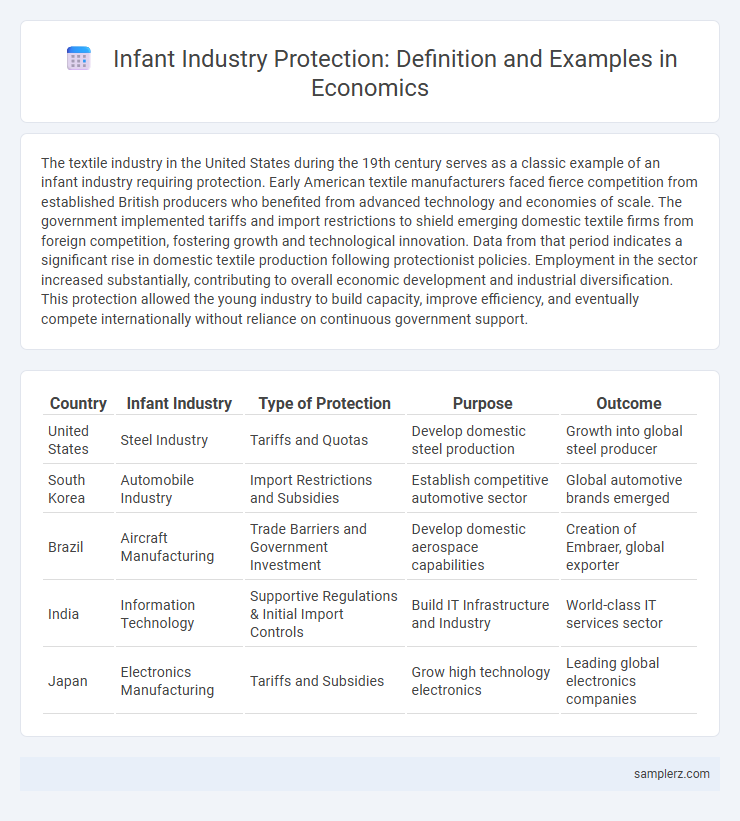The textile industry in the United States during the 19th century serves as a classic example of an infant industry requiring protection. Early American textile manufacturers faced fierce competition from established British producers who benefited from advanced technology and economies of scale. The government implemented tariffs and import restrictions to shield emerging domestic textile firms from foreign competition, fostering growth and technological innovation. Data from that period indicates a significant rise in domestic textile production following protectionist policies. Employment in the sector increased substantially, contributing to overall economic development and industrial diversification. This protection allowed the young industry to build capacity, improve efficiency, and eventually compete internationally without reliance on continuous government support.
Table of Comparison
| Country | Infant Industry | Type of Protection | Purpose | Outcome |
|---|---|---|---|---|
| United States | Steel Industry | Tariffs and Quotas | Develop domestic steel production | Growth into global steel producer |
| South Korea | Automobile Industry | Import Restrictions and Subsidies | Establish competitive automotive sector | Global automotive brands emerged |
| Brazil | Aircraft Manufacturing | Trade Barriers and Government Investment | Develop domestic aerospace capabilities | Creation of Embraer, global exporter |
| India | Information Technology | Supportive Regulations & Initial Import Controls | Build IT Infrastructure and Industry | World-class IT services sector |
| Japan | Electronics Manufacturing | Tariffs and Subsidies | Grow high technology electronics | Leading global electronics companies |
Definition and Concept of Infant Industry Protection
Infant industry protection refers to government policies that support newly established industries to help them develop and compete against established foreign competitors. This protection commonly involves tariffs, subsidies, or import restrictions designed to shield these nascent sectors from international competition until they achieve economies of scale and improved efficiency. The concept is rooted in the idea that temporary government intervention can foster domestic industrial growth, innovation, and economic diversification by allowing emerging industries time to mature.
Historical Overview of Infant Industry Policies
The steel industry in the United States during the 19th century exemplifies infant industry protection, where tariffs and government support nurtured its growth against British competition. Historical overview reveals that these policies enabled domestic manufacturers to develop economies of scale and technological expertise over time. Such protectionist measures were pivotal in transitioning the U.S. into a leading industrial economy.
Classic Case: The U.S. Textile Industry
The U.S. textile industry serves as a classic example of infant industry protection, where tariffs and quotas were imposed in the 19th century to shield emerging domestic manufacturers from established foreign competitors, particularly British textile producers. This strategic protection enabled the U.S. textile sector to develop technological capabilities, expand production, and create jobs, ultimately fostering economic growth and industrialization. Historical data shows that such protectionist measures contributed significantly to the industry's transition from an agrarian economy to a diversified industrial powerhouse.
South Korea’s Electronics Industry Emergence
South Korea's electronics industry exemplifies a successful infant industry protected through targeted government policies in the 1960s and 1970s. Strategic tariffs and import restrictions shielded domestic companies like Samsung and LG, allowing them to develop competitive technologies and scale production. This protection facilitated rapid innovation and export growth, transforming South Korea into a global leader in electronics manufacturing.
Brazil’s Automotive Sector Under Protection
Brazil's automotive sector exemplifies an infant industry benefiting from trade protection through import tariffs and local content requirements. Government policies such as the Inovar-Auto program incentivized domestic production and technological development, allowing local manufacturers like Fiat and Volkswagen to expand market share against global competitors. This protective environment fostered industrial growth, job creation, and technological advancement, supporting Brazil's economic diversification.
India’s Pharmaceutical Industry Development
India's pharmaceutical industry thrived under infant industry protection policies, enabling domestic companies to develop competitive drug manufacturing capabilities. Indian firms capitalized on patent protection reforms and government incentives, which fostered innovation and expanded generic drug production globally. This strategic protection allowed India to become a leading supplier in the global pharmaceutical market, significantly boosting its economy.
Case Study: Malaysia’s Palm Oil Industry
Malaysia's palm oil industry exemplifies an infant industry protected through government policies such as import tariffs and subsidies to nurture domestic production. The sector's growth transformed Malaysia into the world's second-largest palm oil producer, contributing significantly to GDP and rural employment. Strategic protectionism enabled investment in research and development, improving yield and sustainability, crucial for maintaining global competitiveness.
China’s Technology Sector as an Infant Industry
China's technology sector, particularly areas like semiconductor manufacturing and artificial intelligence, exemplifies an infant industry benefiting from protective measures such as tariffs and government subsidies aimed at fostering domestic innovation. Strategic investments by institutions like the China National Integrated Circuit Industry Investment Fund have accelerated growth and reduced dependence on foreign technology. This protection facilitates the development of competitive advantages and supports long-term economic diversification within the evolving global tech landscape.
Lessons from Argentina’s Agricultural Machinery Protection
Argentina's protection of its agricultural machinery sector illustrates the infant industry argument by shielding local manufacturers from foreign competition through tariffs and subsidies. This support allowed domestic firms to innovate and scale production, fostering increased employment and technological advancement in the agriculture equipment industry. However, prolonged protection led to inefficiencies and dependency on government aid, highlighting the importance of time-limited measures and gradual exposure to global markets.
Evaluating Success and Failures in Infant Industry Protection
The South Korean automotive industry exemplifies infant industry protection, where government subsidies and tariffs nurtured domestic manufacturers like Hyundai and Kia, leading to their global competitiveness. Success is measured by increased export volumes and market share, while failures often arise from prolonged dependency on protection, resulting in inefficiencies and reduced innovation incentives. Evaluating such cases highlights the balance between temporary support and long-term self-sufficiency in industrial policy.

example of infant industry in protection Infographic
 samplerz.com
samplerz.com